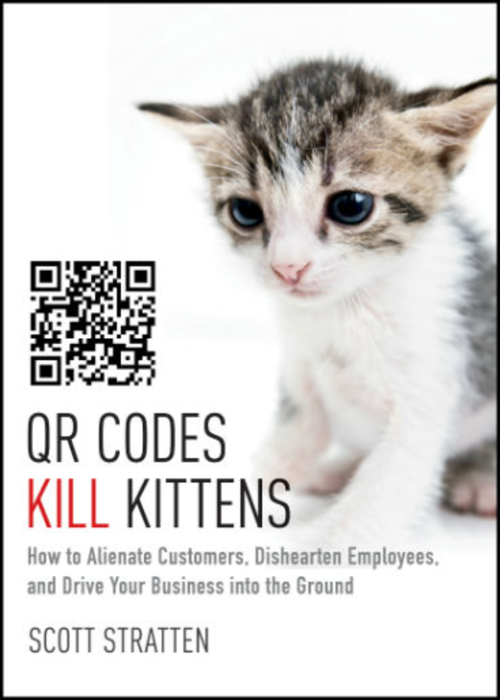You’ve heard it before: Just because you can do something doesn’t mean you should do it. This is the message Scott Stratten aims to deliver to marketers in QR Codes Kill Kittens. Stratten, who also authored UnMarketing, points out that marketing leaders and other senior executives need to be more customer centric, treat employees better, and think before acting—whether that action is something as small as using a QR code or as big as introducing a new corporate policy.
Part of the problem, Stratten suggests, is that executives are too easily distracted by shiny objects. “We ignore the things we should be doing in our business to create and place [QR codes instead],” he writes. “We ignore fixing problems. We put aside improving our products, listening to our customers, and cleaning up the tools we are already using…. We yell, ‘Squirrel!’ and run after them.”
Here, a few tips from QR Codes Kill Kittens on putting the horse back in front of the cart:
Consider functionality: If customers take action on your promotion, they should be able to successfully complete it. For example, does your QR code take customers to a mobile-optimized website? Is it placed somewhere that people can actually scan it?
I often come across QR codes on ads in subway cars. I guess people could scan the code and go to the link when they’re back above ground, but I’m not sure that’s an ideal user experience. Depends on how compelled people are to complete the action.
Pursue the right customers: As much as we all love promotions and contests, all too often running them attracts people who want discounts or prizes and don’t really care much about engaging with or purchasing from the brands offering them in the future. Is your Facebook contest, for instance, getting your page likes from people who will never return or view your posts or who will unlike you as soon as the contest ends?
Devise your strategy first: Rushing in to keep up with or stay ahead of competitors has its merits—if thought through enough. Sure, it’s fine to experiment, fail fast, learn, and improve. But does that test make sense in the first place? Consider the mobile app that has no unique functionality and is basically a fancy link to a brand’s website. But, hey, at least you have an app… Sure, but customers may only open it once.
Be social: OK, we all know the whole point of building customer relationship is to sell more stuff. Most customers want to be wooed first, and feel that you’re as interested in their needs and preferences as you are their wallet. So it’s important to be social on social networks and to create a connection before pitching. Offer advice and content, for instance. Like dating, building relationships over time will help marketers gather more data and make more sales. Unless you’re drunk in Vegas, rarely do marriage proposals fly on the first date.
Think before you post: Whether it’s a video or photo, a tweet or pin, a blog or comment, or some other form of online interaction, think twice before you post it. Does it reflect well on you personally and professionally? Does it represent your brand? Putting “my comments are my own” doesn’t really fly. And automating responses is rarely a good idea.
Have the courage to say good-bye: Not all customer relationships are good ones, and not all customers are right for a business. Embrace opt-outs.








